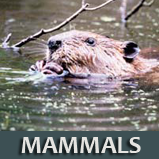
Many species of reptiles and amphibians in North Carolina are threatened by human activity. Some of the larger reptiles, including all of the marine turtles and alligators, have been decimated by hunting; now considered endangered species, they are protected by American and international law. Populations of numerous species of smaller reptiles are declining due to habitat destruction by humans.
Twelve species of lizards have been identified in the state. A single colony of the spiny Texas horned lizard is known to exist in Onslow County. Other species include the northern fence lizard, the green anole, five species of skinks, and the six-lined racerunner.
Thirty-seven species of snakes are known to live within the state boundaries, with 31 local species of nonvenomous snakes representing the diverse worldwide Colubridae family inhabiting a wide variety of habitats. Well-known members of this family include the garter, black racer, corn, black rat, ringneck, hognose, milk, coachwhip, and king snakes. The semiaquatic cottonmouth inhabits marshes, swamps, rivers, and streams of the Coastal Plain and the eastern Piedmont. Five species of Viperidae, the poisonous family of snakes with the characteristic heat-sensitive pit between the eye and nostril on either side of a wide head, are found in North Carolina. Three species-the eastern diamondback, pygmy, and timber-are rattlesnakes. The poisonous copperhead can be found in or near forests in all parts of North Carolina. Copperheads inflict the most snake bites to humans in the state, but only one human fatality has been documented in the last century.
Twenty-one species of turtles have been reported in North Carolina or its adjacent coastal waters. The largest of these ancient reptiles are marine turtles. The leatherback sea turtle, the world's largest living turtle, has been observed along the coast but probably does not go ashore to lay eggs. Four other species of marine turtles-the loggerhead, green, Atlantic hawksbill, and Atlantic ridley-range along local coastal waters and estuaries, but only the loggerhead turtle commonly builds nests on beaches, primarily south of Cape Lookout. Numerous other species of aquatic and terrestrial turtles live in North Carolina. The largest of these is the common snapping turtle, which should be treated with caution because of its powerful jaws.
Numerous indigenous salamander, frog, and toad species live in practically every habitat in the state. Important frog species include the bullfrog, Carolina gopher frog, river frog, and southern leopard frog. There are also a number of tree frog species, such as the southern cricket frog, green tree frog, and southern peeper frog. Toad species include the American toad, oak toad, and southern toad. Salamanders abound in North Carolina and the Southeast, living in or near rivers, creeks, and swamps. The state's giant salamander population includes the Neuse River waterdog and the dwarf waterdog. Lungless salamanders include the southern two-lined salamander, dwarf salamander, Junaluska salamander, and eastern mud salamander. The red-spotted newt is also a species of salamander in the state.
Learn more about North Carolina's:


